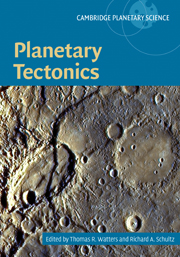Book contents
- Frontmatter
- Contents
- List of contributors
- Preface
- 1 Planetary tectonics: introduction
- 2 The tectonics of Mercury
- 3 Venus tectonics
- 4 Lunar tectonics
- 5 Mars tectonics
- 6 Tectonics of small bodies
- 7 Tectonics of the outer planet satellites
- 8 Planetary structural mapping
- 9 Strength and deformation of planetary lithospheres
- 10 Fault populations
- Index
- Plates
- References
9 - Strength and deformation of planetary lithospheres
Published online by Cambridge University Press: 30 March 2010
- Frontmatter
- Contents
- List of contributors
- Preface
- 1 Planetary tectonics: introduction
- 2 The tectonics of Mercury
- 3 Venus tectonics
- 4 Lunar tectonics
- 5 Mars tectonics
- 6 Tectonics of small bodies
- 7 Tectonics of the outer planet satellites
- 8 Planetary structural mapping
- 9 Strength and deformation of planetary lithospheres
- 10 Fault populations
- Index
- Plates
- References
Summary
Summary
Robotic missions to destinations throughout our solar system have illuminated in increasing detail evidence of past and present tectonics combined with manifestations of internal dynamics. Interpretation of observations, such as sustenance of high mountains on Venus for potentially hundreds of millions of years, formation of the grooved terrain on the surface of Ganymede, and tidally driven tectonics and volcanism on Io, requires the application of realistic constitutive equations describing the rheological properties for the materials that constitute the crusts and interiors of these planetary bodies. Appropriate flow laws can only be derived from careful experimental studies under conditions that may be reliably extrapolated to those believed to exist on and in the planetary body under consideration. In addition, knowledge of the appropriate rheological behavior may, coupled with measurements made from orbiting satellites, enable the determination of geophysical properties, such as heat flow, that are otherwise not quantifiable without an expensive surface mission. In this chapter, we review the current state of knowledge of the rheological properties of materials appropriate to understanding tectonic behavior and interior dynamics for the terrestrial planets as well as the major Jovian satellites. We then discuss the utility of experimentally constrained constitutive equations in understanding large-scale processes on Venus, Mars, Europa, Ganymede and Io.
Introduction
Historically, much of our understanding of the deformation behavior of planetary materials derives from experimental investigations undertaken to explore the mechanical properties of minerals and rocks as related to tectonic processes on our own planet, Earth.
- Type
- Chapter
- Information
- Planetary Tectonics , pp. 397 - 456Publisher: Cambridge University PressPrint publication year: 2009
References
- 12
- Cited by

